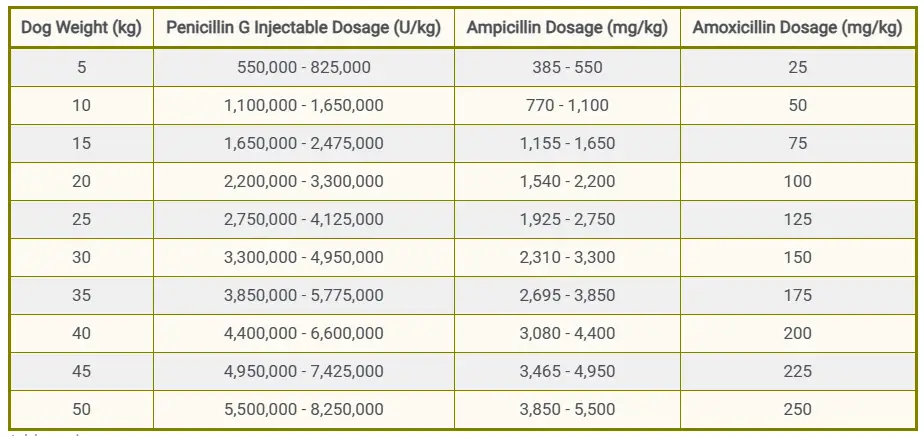Penicillin for dogs is a commonly used antibiotic in veterinary medicine to treat bacterial infections in dogs. It belongs to the beta-lactam class of antibiotics and is effective against a wide range of bacteria.
Penicillin is derived from molds of the Penicillium fungi. It works by interfering with the formation of bacterial cell walls, leading to the death of the bacteria.
This antibiotic is available in various forms, including oral tablets, injectable solutions, and topical ointments.
What is Penicillin For Dogs?
Penicillin for dogs is an antibiotic medication commonly prescribed by veterinarians to treat bacterial infections. It belongs to a class of antibiotics known as beta-lactams and works by inhibiting the growth of bacteria.
Penicillin can be used to treat a variety of bacterial infections in dogs, including skin infections, respiratory infections, urinary tract infections, and some types of ear infections.
However, it’s essential to use penicillin only under the guidance of a veterinarian, as incorrect use or dosage can lead to adverse effects or the development of antibiotic resistance.
Disclaimer: Self-medication can be hazardous. Please consult your veterinarian for personalized guidance on the appropriate dosage for your furry friend’s specific condition.
Types of Penicillin For Dogs
There are various types of dog penicillin that can be used, depending on the specific infection being treated and the veterinarian’s recommendation. Some common types include:
- Penicillin G : This is one of the oldest and most widely used forms of penicillin. It is effective against a broad range of bacteria and is often used to treat infections such as skin infections, respiratory infections, and urinary tract infections in dogs.
- Penicillin V: Similar to Penicillin G, Penicillin V is effective against many types of bacteria. It is often used to treat mild to moderate infections in dogs, including skin infections and dental infections.
- Amoxicillin: While not technically a penicillin, amoxicillin is a related antibiotic that is often used in canines. It is effective against a wide range of bacteria and is commonly used to treat respiratory infections, urinary tract infections, and skin infections in dogs.
- Ampicillin: Another related antibiotic, ampicillin is similar to amoxicillin and is effective against many types of bacteria. It is often used to treat infections such as respiratory infections, urinary tract infections, and gastrointestinal infections in puppies.
Penicillin Dosage For Dogs
- Penicillin G Injectable Dosage For Dogs: The recommended daily dosage of penicillin G for dogs typically ranges from 110,000 to 165,000 units per kilogram (50,000-75,000 units per pound).
- Ampicillin Dosage For Dogs: The typical dosage of ampicillin for dogs ranges from 77 to 110 milligrams per kilogram (35-50 milligrams per pound) of body weight.
- Amoxicillin Dosage For Dogs: The usual dosage of amoxicillin, which is a member of the penicillin family, is 5 milligrams per pound of body weight, administered twice daily.
Penicillin Dosage Chart For Dogs By Weight
| Dog Weight (kg) | Penicillin G Injectable Dosage (U/kg) | Ampicillin Dosage (mg/kg) | Amoxicillin Dosage (mg/kg) |
|---|---|---|---|
| 5 | 550,000 – 825,000 | 385 – 550 | 25 |
| 10 | 1,100,000 – 1,650,000 | 770 – 1,100 | 50 |
| 15 | 1,650,000 – 2,475,000 | 1,155 – 1,650 | 75 |
| 20 | 2,200,000 – 3,300,000 | 1,540 – 2,200 | 100 |
| 25 | 2,750,000 – 4,125,000 | 1,925 – 2,750 | 125 |
| 30 | 3,300,000 – 4,950,000 | 2,310 – 3,300 | 150 |
| 35 | 3,850,000 – 5,775,000 | 2,695 – 3,850 | 175 |
| 40 | 4,400,000 – 6,600,000 | 3,080 – 4,400 | 200 |
| 45 | 4,950,000 – 7,425,000 | 3,465 – 4,950 | 225 |
| 50 | 5,500,000 – 8,250,000 | 3,850 – 5,500 | 250 |
The above Penicillin dosage chart for dogs by weight is provided for educational purposes only and should not substitute for veterinary advice. Always start with the minimum dose for you feline until your vet prescribes an increase in dosage.
Common Brand Names
- Human Variants: (Apothecon), Pfizerpen® (Roerig), Penicillin G Potassium®
- Veterinary Variants: Crystacillin® (Solvay), Flo-Cillin® (Fort Dodge), Crystiben® (Solvay), Dual-Pen® (TechAmerica)
Penicillin For Dogs Uses
- Skin Infections:
- Penicillin is often prescribed to treat bacterial skin infections in dogs, such as pyoderma or hot spots. These infections can result from wounds, allergies, or other underlying skin conditions.
- Respiratory Infections:
- Penicillin can be used to treat respiratory tract infections in dogs, including bronchitis, pneumonia, and kennel cough. These infections are often caused by bacteria such as Bordetella bronchiseptica or Streptococcus spp.
- Urinary Tract Infections (UTIs):
- Penicillin may be prescribed to treat urinary tract infections in dogs caused by susceptible bacteria. UTIs can cause discomfort and may lead to more severe complications if left untreated.
- Dental Infections:
- Infections in the oral cavity, such as periodontal disease or dental abscesses, can be treated with penicillin. These infections can lead to pain, tooth loss, and systemic illness if not addressed.
- Soft Tissue Infections:
- Penicillin can be used to treat various soft tissue infections in dogs, including abscesses, cellulitis, and infected wounds. These infections can occur due to injuries, bites, or surgical wounds.
- Bacterial Septicemia:
- In cases of bacterial septicemia, where bacteria have entered the bloodstream and caused systemic infection, penicillin may be administered to help combat the infection and prevent further complications.
Related Post: Panacur Dosage For Dogs
Penicillin Side effects in Dogs
- Allergic reactions (ranging from mild itching to severe anaphylaxis)
- Gastrointestinal upset (nausea, vomiting, diarrhea)
- Injection site reactions (pain, swelling, abscess)
- Overgrowth of non-susceptible bacteria (such as Clostridium difficile)
- Hypersensitivity reactions (fever, lethargy, weakness)
- Neurological effects (seizures, tremors)
- Kidney damage (with high doses or prolonged use)
- Liver dysfunction (especially in dogs with pre-existing liver disease)
- Overuse of penicillin and other antibiotics can contribute to antibiotic resistance, making it less effective in treating bacterial infections over time.
Which Dogs Should Not Take Penicillin G, Penicillin v, Ampicillin and Amoxicillin.
Canines with the following health issues should not take Penicillin without veterinary recommendations.
- Allergic Dogs
- Dogs with Pre-existing Health Conditions
- Pregnant or Nursing Dogs
- Small Breed Dogs
- Senior Dogs
FAQs
Can I give my dog penicillin for any type of infection?
Penicillin is effective against certain bacterial infections in dogs. However, it’s essential to consult with a veterinarian before administering any medication to your dog.
What are the signs of an allergic reaction to penicillin in dogs?
Signs of an allergic reaction to penicillin in dogs may include itching, swelling, hives, vomiting, diarrhea, and difficulty breathing.
How long does it take for penicillin to work in dogs?
The timeframe for penicillin to work in dogs varies depending on the type and severity of the infection. Improvement is usually seen within a few days of starting treatment.
Can penicillin be used to treat viral infections in dogs?
No, penicillin is only effective against bacterial infections and cannot treat viral infections in dogs.
Are there any side effects of long-term penicillin use in dogs?
Long-term use of penicillin in dogs can lead to antibiotic resistance and gastrointestinal upset. It’s essential to use antibiotics responsibly and under the guidance of a veterinarian.




![Can Dogs Eat Blood? 7 Side Effects [Expert Opinion]](https://petskor.com/wp-content/uploads/2022/04/Webp.net-resizeimage-12.jpg)

